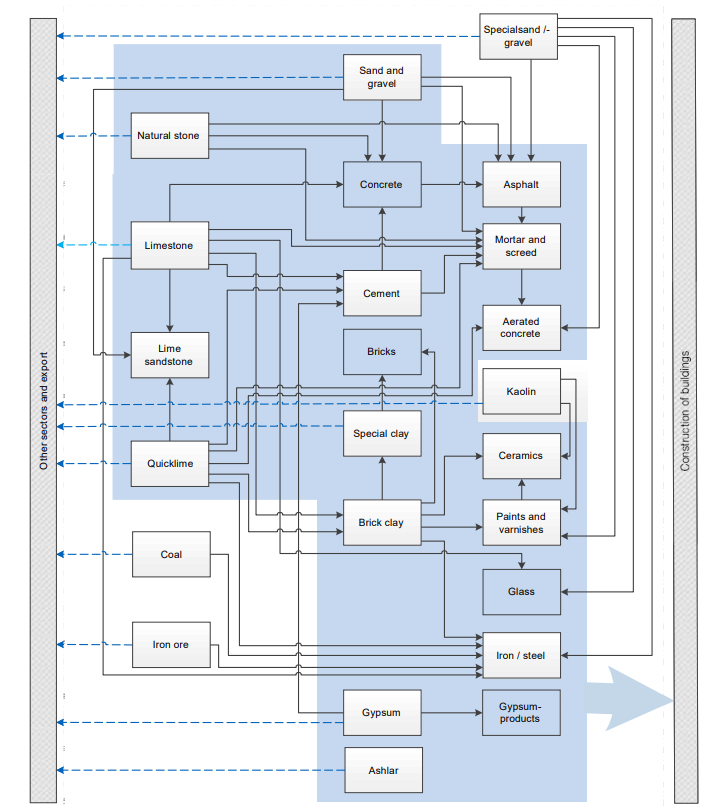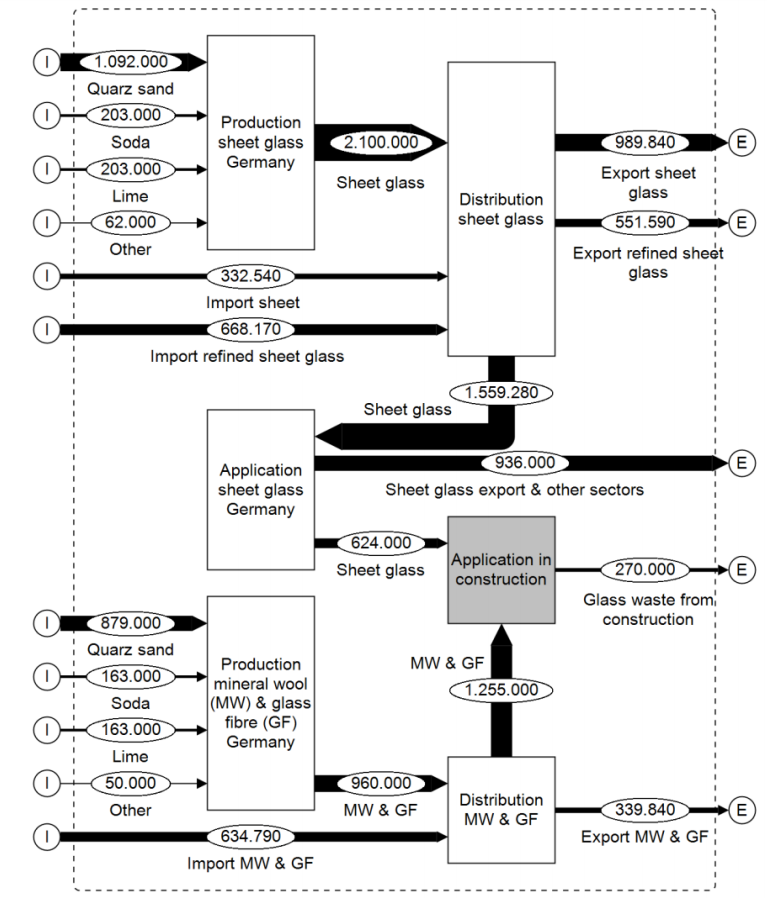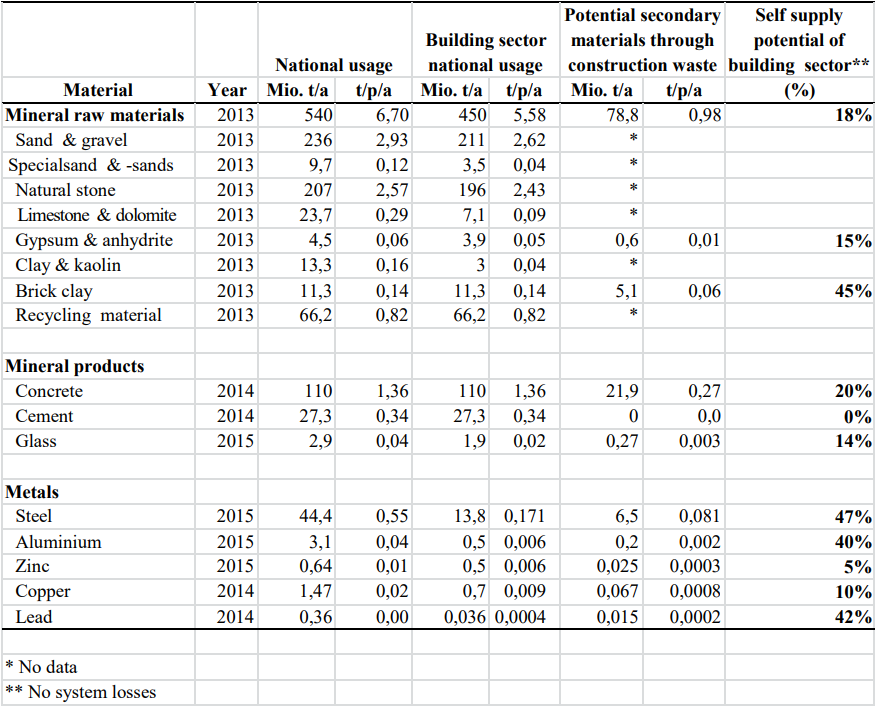Material flows of the German building sector
Contents |
Abstract
According to estimates of the German Federal Ministry for the Environment, the German building stock contains around 10.5 billion tonnes of mineral building materials, around 220 million tonnes of timber products and around 100 million tonnes of metals. Due to continuous building activities, especially renovation and retrofit measures, it is estimated that this raw material stock will grow by a further 20 % until 2050 [1].
Every year more than 450 million tonnes (5.6 t/person) of mineral raw materials (e.g. sand, gravel) and more than 15.5 million tonnes (194 kg/person) of metals (e.g. steel, aluminium, copper) are required within the sector for maintaining and constructing new buildings. The focus of this paper is the analysis of construction related raw material flows using material flow analysis (MFA) in Germany. To provide system control options in a circular economy, a deeper knowledge about material flows and stocks is required. A large range of statistical data (e.g. production, import/export, waste, etc.) was evaluated and disaggregated, to investigate the impact and self-supply potential through secondary materials, of the German building industry.
Currently, the demand cannot be covered by recycled materials leaving the building sector and further primary raw materials are needed. Potentially, only 18% of the mineral raw materials can be substituted by recycled construction waste. In contrast, for steel and aluminium the substitution rate has reached levels over 40%.
Introduction
The overall aim of the PhD thesis is the analysis and capture of construction induced material flows and stocks in urban systems and the identification of control options. Material flows are not limited to a single spacial level (e.g. urban, regional, national) or an individual industry sector (e.g. construction, automotive, chemical). Depending on the regarded material, the system boundaries are flexible and can change over time, especially on a spatial level.
One of the project work packages was the focus on national construction induced material flows. The results of this work package are described within this paper.
Approach
The dependencies of selected materials and products used within the German construction industry were identified (Figure 1). Each of the materials and products where viewed as a black box at first.
[Figure 1. Material flow and interdependencies of selected construction materials]
The black box view was extended to gain an insight into the individual flows on a material level (e.g. glass, steel). As an example, the material flow of glass is shown in figure 2. This extended assessment was continued for the other materials shown in figure 1 and integrated into the model.
[Figure 2. Material flow of glass within German construction sector (tons/year)]
A large range of statistical data (e.g. production, import/export, waste, etc.) was evaluated and disaggregated. Together with expert knowledge a detailed picture of construction induced material flows for selected materials could be identified.
Results
Of the selected materials, steel has shown to have the highest self-supply potential through secondary materials of nearly 50%, disregarding system losses. Also the demand of aluminium, lead and bricks used for construction purposes can potentially be covered by around 40%, through the use of incurred construction waste. The results are summarised in Table 1.
Table 1. Self-supply potential with secondary construction materials within the German building sector for selected materials
Conclusion
Due to the continuous growth of the construction stock, a larger amount of materials is required than can be provided through construction waste. Metals, with the exception of zinc and copper, tend to have higher self-supply potentials than other materials.
For continuous monitoring of construction induced materials flows on a national level, an improved and integrated system of data collection and documentation is required, that uses the same terminology. The often incompatible statistics leave room for interpretation, which needs to be reduced.
Acknowledgement
This research is part of the BAMB project (www.bamb2020.eu). The BAMB project has received funding from the European Union’s Horizon 2020 research and innovation program under grant agreement No. 642384.
References
[1] Internationaler Ressourceneffizienzatlas (2011), http://www.ressourceneffizienzatlas.de/beispiele/strategien/detail/article/urban- mining-staedte-als-rohstoffquelle.html (Accessed on 20.03.2015)
Matthias A. Heinrich
Technical University of Munich, Institute of Energy Efficient and Sustainable Design and
Building, Centre for Sustainable Building, Arcisstraße 21, 80333 München, Phone (+49) 289 23969, email: [email protected]
--BAMB - Buildings As Material Banks 13:34, 16 Aug 2018 (BST)
Related articles on Designing Buildings Wiki
About the wiki
Anyone is welcome to use and contribute to the wiki in different ways.
[edit] Engaging with the wiki
You can:
- Contribute to existing articles
- Create articles
- Share articles through social media and other channels
- Contact the CIRCuIT project to let us know what you think and how we can improve
[edit] Add your own content
To contribute to or create an article, you can follow these steps:
- Register as a user
- Read through the editorial policy and guidance on writing and contributing to articles
- See the detailed help page on tips on writing wiki articles
- Try editing a test article
- If editing an article, select 'Edit this article' underneath the article title
- If creating a new article, select 'Create an article'. In the 'Select categories' area, expand the 'Industry context' list and tag 'Circular economy' to add your article to this wiki
[edit] Who is this wiki for?
The articles contain information on implementing circular economy approaches in construction that could be relevant to:
- Architects
- Construction contractors
- Designers
- Developers, owners, investors
- Engineers
- Landowners
- Manufacturers and supplier
- Universities and research
- Urban planners
[edit] About CIRCuIT
The Circular Economy wiki is supported by the Circular Construction in Regenerative Cities (CIRCuIT) project, which is funded by the European Union's Horizon 2020 research and innovation programme. CIRCuIT is a collaborative project involving 31 ambitious partners across the entire built environment chain in Copenhagen, Hamburg, Helsinki Region and Greater London. Through a series of demonstrations, case studies, events and dissemination activities, the project will showcase how circular construction practices can be scaled and replicated across Europe to enable sustainable building in cities and the transition to a circular economy on a wider scale.









